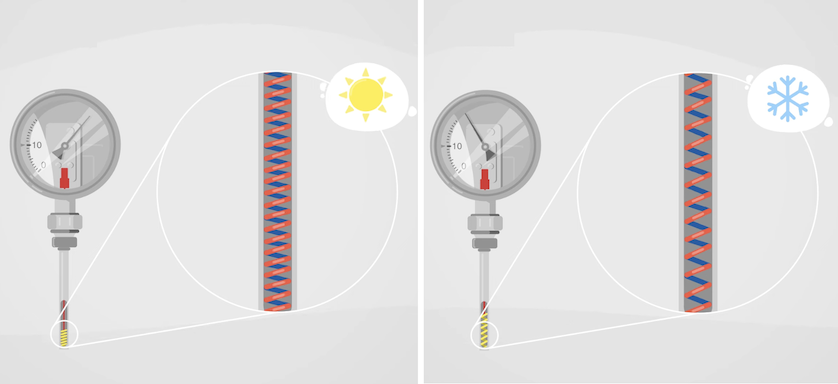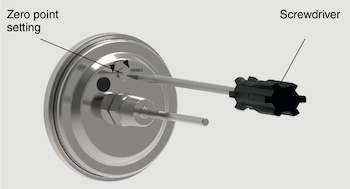
Bimetal thermometers are tried-and-true instruments for measuring temperature in a wide range of industrial applications, combining low cost and low maintenance with easy installation, use, and calibration.
Sometimes a measurement technology is so simple yet effective that it becomes – and remains – the standard for decades. Such is the case with the bimetal thermometer (also called bimetallic thermometer), patented in the late 1800s.
Operating Principle of Bimetal Thermometers
Bimetal thermometers work on the principle that solids expand or contracts depending on the temperature. As the name implies, these temperature measurement devices contain two strips of metal, each with a different expansion coefficient. This means that at the same temperature, the two metals will expand or contract at different rates. The materials are usually steel and copper or steel and brass, depending on the measuring range.
The two strips are welded or bonded together, formed into a helical or spiral coil, and placed in the thermometer’s stem. The bimetallic coil is affixed at the stem end, while the other end rotates and moves the pointer. As the temperature increases, the strip bends toward the metal with the lower temperature coefficient and creates a rotational movement in one direction. Conversely, as the temperature decreases, the strip bends toward the metal with the higher temperature coefficient and creates a rotational movement in the other direction.
Benefits of Using Bimetal Thermometers
Because these thermometers use common metals and a simple mechanical technology, they are among the least expensive industrial thermometers available. These dial thermometers are also durable, giving them an advantage over both liquid-expansion and gas-actuating thermometers.

Easy recalibration with zero point setting
Reasons to use bimetal thermometers:
- Low price
- Low maintenance
- Easy onsite calibration (zero-point resetting via back of the case)
- Near-linear response to temperature changes
- Suitable for a wide temperature range, from −94°F to 1,112°F (−70°C to +600°C)
- Robust design, making them suitable for high-vibration applications
- No need for wiring or power source, for easy installation, operation, and maintenance
The advantages of bimetallic thermometers contribute to some of their disadvantages:
- Slow response time
- Require regular recalibration
- Local indication only (unless paired with a temperature transmitter)
See this video for an overview of bimetal vs. gas-actuated thermometers.
Uses of Bimetal Thermometers
Bimetallic thermometers are found in a wide variety of process industries, providing reliable, inexpensive onsite temperature readings for applications in:
- Oil and gas
- Chemical and petrochemical
- Food and beverage, such as ovens, boilers, and process lines
- Pharmaceutical and biotechnology
- Water and wastewater treatment
- Basic materials, like pulp and paper
These instruments’ versatility and simple operation also make them ideal for:
- Heating, ventilation, and air handling, including hot water tanks and solar thermal systems
- Industrial refrigeration
- Machine building
- Testing and laboratories
For use in applications with high pressure or aggressive media, place the bimetal thermometer stem in a thermowell. A thermowell also makes it easy to exchange/replace the thermometer without emptying the heating circuit. In situations with significant vibration, a liquid case fill and damping bushings greatly minimize pointer oscillation.
Types of Bimetal Thermometers by WIKA
WIKA offers a wide variety of high-quality yet economical bimetal thermometers:
Bimetal thermometers for industrial applications
- A46 bimetal thermometer for heating technologies, special versions
- A48 bimetal thermometer for measuring temperature in air ducts
- A50 bimetal thermometer for air handling, standard version
- A52 (back mount) and R52 (lower mount) entry-level bimetal thermometers for industrial applications
- A2G-61 bimetal thermometer for ventilation duct temperature sensing
- 20 2″ industrial grade bimetal thermometer, all stainless steel construction
- TG51 3″ and 5″ industrial grade bimetal thermometer, all stainless steel constriction
Bimetal thermometers for process industries
- TG53 process-grade bimetal thermometer per ASME B40.200, all stainless steel construction
- 55 process-grade bimetal thermometer per EN 13190, all stainless steel construction (available in a special version for low ambient temperatures, part of WIKA’s POLAR series)
Bimetal thermometers with transmitting option
These twin-temp thermometers come with transmitting accessories and options for local mechanical indication combined with remote electrical signal in one probe.
- 30 (3″ back connected dial)
- 50 (5″ back connected dial)
- 32 (3″ adjustable dial)
- 52 (5″ adjustable dial)
Bimetal thermometer and pressure gauge (tridicator)
- 0X/100.1X thermomanometer (combined temperature and pressure measurement)
General purpose / utility bimetal thermometers
- 1005 pocket test thermometer
- TI-ST surface mount thermometer with two magnets, attaches to any ferrous surface
- T17 (1.75“) and TI.T20 (2“) bimetal thermometers with thin stem and back connection
Guidance on Choosing Bimetallic Thermometers
There’s more to thermometers than simply price point, dial size, and temperature range. For personalized advice on which bimetal thermometer to use, or whether your application would benefit from another type of dial thermometer (liquid expansion, gas-actuated) or electronic temperature sensor (RTD, thermocouple, digital temperature indicator), contact the temperature specialists at WIKA USA.

